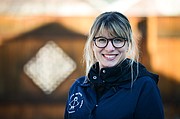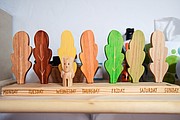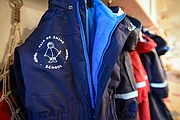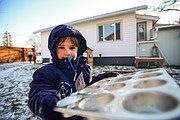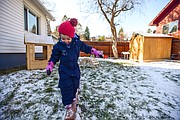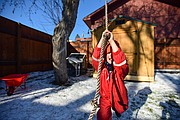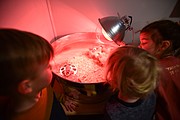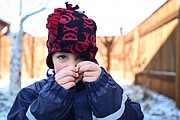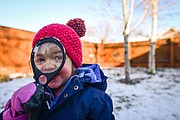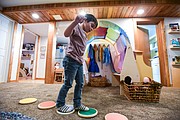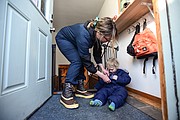Natural rhythm — Mission of Rain or Shine 'forest school' in Somers is to get children outdoors
HILARY MATHESON | Hagadone News Network | UPDATED 3 years, 9 months AGO
No matter the weather, children attending Rain or Shine School are ready to explore, play, learn and grow.
Located in Somers, Rain or Shine is a nature-based school and daycare program. Currently, the program is open to children ages 2 to 6 with plans to expand to ages 7 through 13 in the 2022-23 school year.
Owner and director Kayla Vernon opened a gate to the Rain of Shine School on a recent day where children were immersed in unstructured play outside. On one side of the yard, a child swung from a rope anchored to a tree. On the other side, a group of children were “baking” by busily packing dirt into muffin tins. Toward the back of the yard, a child exclaimed with delight that he found a seed within the red skin of a berry plucked from a bush. Taking the small seed, he hunkered down by a plot of bare soil and buried it.
Rain or Shine joins a growing community of nature-based, Scandinavian-inspired “forest schools” operating in the Flathead Valley where the great outdoors serves as the biggest classroom of all.
“We’re really lucky because we have the Rails to Trails right there, so we’re going to do nature walks and the new state park is going in here around the corner on the north shore — we’ll spend a lot of time there too,” she said.
Being in the Flathead, she incorporates lessons about and hopes to build connections with members of the Confederated Salish and Kootenai Tribes.
“We talk to the children about how nature, we’re really grateful to be able to spend time out in nature and part of that history is who originally occupied the lands, which were the tribes in this area.”
While the children spend a significant time outside, Rain or Shine School, which opened Feb. 1, also has an indoor component to the day where activities employ the principles of the Waldorf education method, which is steeped in experiential learning, or “learning by doing.” At the early childhood level, this is accomplished through unstructured play, stories, songs, circle time and art.
“Waldorf early education is all about allowing children to be creative and have that freedom to explore,” she said.
Just as nature-based schools do, the Waldorf tradition follows the seasons.
“We rotate everything seasonally,” she said. “We were learning how everything went to sleep and how everything goes in and kind of rests during this time of year, and then [recently] we just had little baby chicks so we got to see that life cycle.”
When it’s time to go indoors, staff member Kate Trunkle alerts the group they have two more minutes outside.
“OK, two minutes friends and then it’s time to clean up,” Trunkle said.
MOVING INSIDE a set of stairs leads to a cozy, and inviting room, which is intentional.
“We want them to feel like they’re in a family home environment,” she said, noting that some of the children may attend daycare for 10 hours a day. “This is an extension of their home life and that’s exactly what I want to build with our learning community too.”
Simple toys made out of natural wood line shelves waiting for children to pick them up and fill in the blanks on color and function using their imaginations.
“All toys are open-ended, which means there’s no right way to use them,” she said.
A basket next to a wardrobe of dress-up clothes holds handmade dolls, some of which have no facial features.
“We’re mixed age. The dolls without faces, that is appropriate for children under three because once you start giving visuals for children then that’s how they see you — see life.”
Vernon pointed to a room off of the kitchen where the red glow of a warming lamp emanates through the darkness.
“That’s where the chickens are,” she said smiling.
Student Dane Fredenberg swiftly made his way to the chickens and pulled up an arch-shaped piece of furniture to step on.
“I named that one Bacon,” he said, pointing. “And that’s Chip and that’s Monkey.”
The chicks, which includes Pony and Fruitsnack huddled together in the round metal tub.
Eventually, it’s time for a guided activity. Vernon and her two assistants, Trunkle and Tianna Thomas, who refer to themselves as guides, set out watercolor paints, brushes and wetted paper. The children each take a seat and dip their brushes into the paints.
“We’re whirling and twirling. Whirling and twirling,” Vernon said in a calm singsong voice, as she painted a circle, noting that instruction is typically tied to the rhythms of song and story, as the day follows a rhythm of play and rest.
“Everything is natural and holistic in the aspect of — we mirror what a natural body would do,” she said.
VERNON INITIALLY discovered the concept of an outdoor forest school with an indoor component based in the Waldorf method through the program her own child attended. Vernon said her son, who has attention deficit hyperactivity disorder, had improved focus with the added exercise and movement throughout the day.
“It’s actually found that the average American child only spends seven minutes outside in structured play for the day. I grew up on a 50-acre ranch. I grew up outside climbing trees and doing outside things and I wanted that for my son too. When he was younger, I started searching for a better way for education because, in kindergarten, he was having a 15-minute recess … that’s not enough.”
Inspired by what she learned, she went on to obtain a master’s degree in early education and wrote her thesis on outdoor education.
With a waiting list of 50, Vernon is forging ahead with plans to expand the program through age 14 (sixth grade) for the 2022-23 school year.
While the early childhood program will remain in Somers, she is looking for property to house the school-age program.
“That’s what we’re currently looking for whether that be someone’s farm, or ranch they're looking to lease out, or if anyone has some land they have an extra structure on is kind of what we’re looking at too,” she said.
By the time children are ready to enter a traditional high school, Vernon said the transition shouldn’t be jarring.
“I always use this analogy. You can teach a 50-year-old to read, but you can't teach a 50-year-old confidence. As long as they have that self-confidence, a confident child can integrate into any situation,” she said.
For more information visit www.rainorshineschool.com.
Reporter Hilary Matheson may be reached at 406-758-4431 or by email at [email protected].
ARTICLES BY HILARY MATHESON

Christmas tradition: Business continues helping customers capture the holiday spirit
Snowline Acres owners Tom and Kristin Davis are approaching a decade of helping people celebrate the most wonderful time of the year.
Whitefish High School wins East Helena speech and debate tournament
Scoring 225 points, the Whitefish High School speech and debate team took first place at a weekend tournament.

Glacier High speech and debate team secures second in Bozeman
The Glacier High School speech and debate team secured second place, and Flathead High School, third in Bozeman.















